GMC SIERRA 1999 Owner's Manual
Manufacturer: GMC, Model Year: 1999, Model line: SIERRA, Model: GMC SIERRA 1999Pages: 440, PDF Size: 2.94 MB
Page 271 of 440
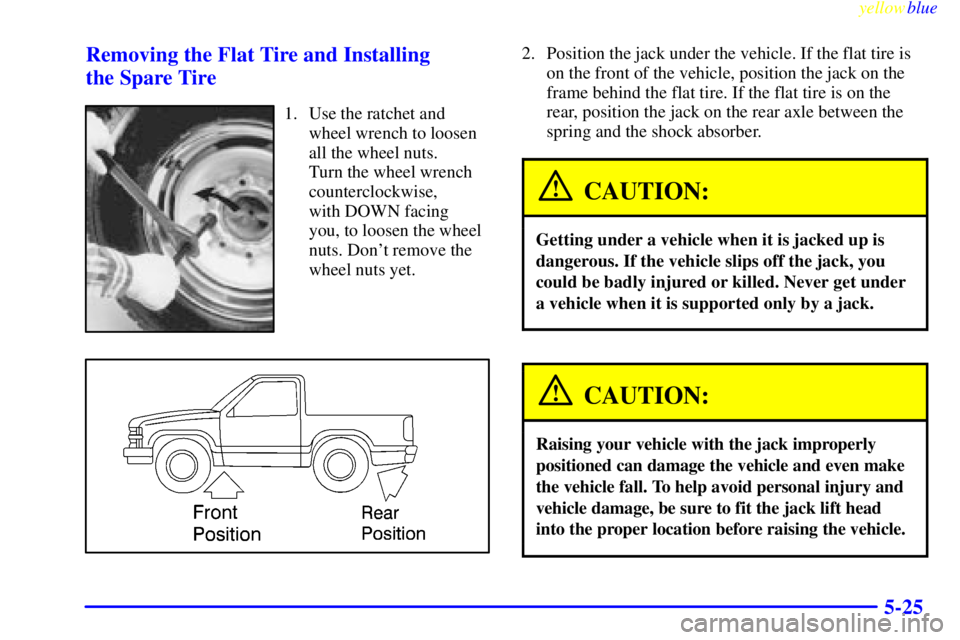
yellowblue
5-25 Removing the Flat Tire and Installing
the Spare Tire
1. Use the ratchet and
wheel wrench to loosen
all the wheel nuts.
Turn the wheel wrench
counterclockwise,
with DOWN facing
you, to loosen the wheel
nuts. Don't remove the
wheel nuts yet.
2. Position the jack under the vehicle. If the flat tire is
on the front of the vehicle, position the jack on the
frame behind the flat tire. If the flat tire is on the
rear, position the jack on the rear axle between the
spring and the shock absorber.
CAUTION:
Getting under a vehicle when it is jacked up is
dangerous. If the vehicle slips off the jack, you
could be badly injured or killed. Never get under
a vehicle when it is supported only by a jack.
CAUTION:
Raising your vehicle with the jack improperly
positioned can damage the vehicle and even make
the vehicle fall. To help avoid personal injury and
vehicle damage, be sure to fit the jack lift head
into the proper location before raising the vehicle.
Page 272 of 440

yellowblue
5-26
Front Position Rear Position
3. With UP on the ratchet facing you, raise the vehicle
by rotating the ratchet and wheel wrench clockwise.
Raise the vehicle far enough off the ground so there
is enough room for the spare tire to fit.
4. Remove all the wheel
nuts and take off the
flat tire.
5. Remove any rust or dirt
from the wheel bolts,
mounting surfaces and
spare wheel.
Page 273 of 440
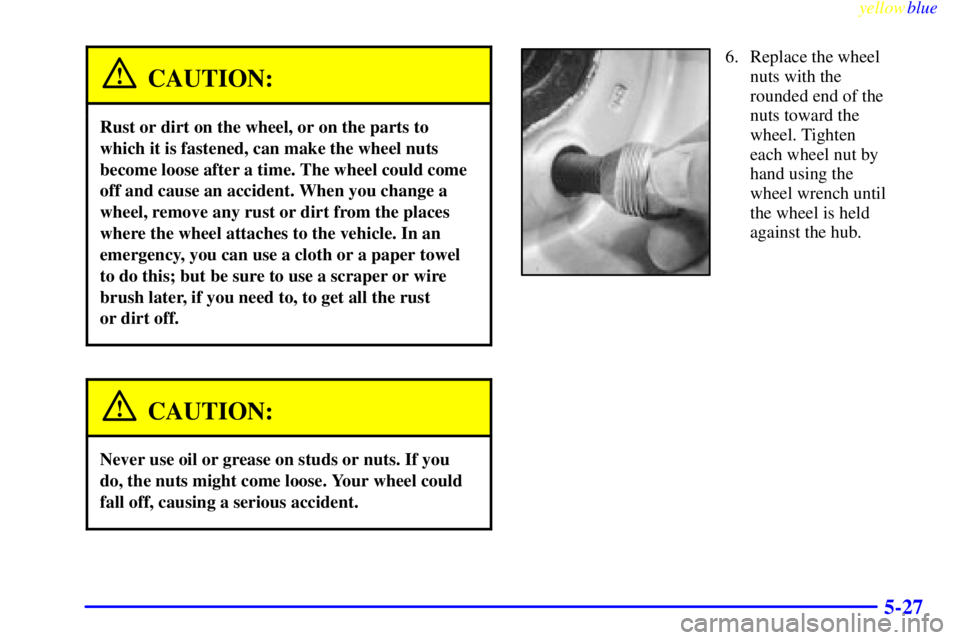
yellowblue
5-27
CAUTION:
Rust or dirt on the wheel, or on the parts to
which it is fastened, can make the wheel nuts
become loose after a time. The wheel could come
off and cause an accident. When you change a
wheel, remove any rust or dirt from the places
where the wheel attaches to the vehicle. In an
emergency, you can use a cloth or a paper towel
to do this; but be sure to use a scraper or wire
brush later, if you need to, to get all the rust
or dirt off.
CAUTION:
Never use oil or grease on studs or nuts. If you
do, the nuts might come loose. Your wheel could
fall off, causing a serious accident.
6. Replace the wheel
nuts with the
rounded end of the
nuts toward the
wheel. Tighten
each wheel nut by
hand using the
wheel wrench until
the wheel is held
against the hub.
Page 274 of 440
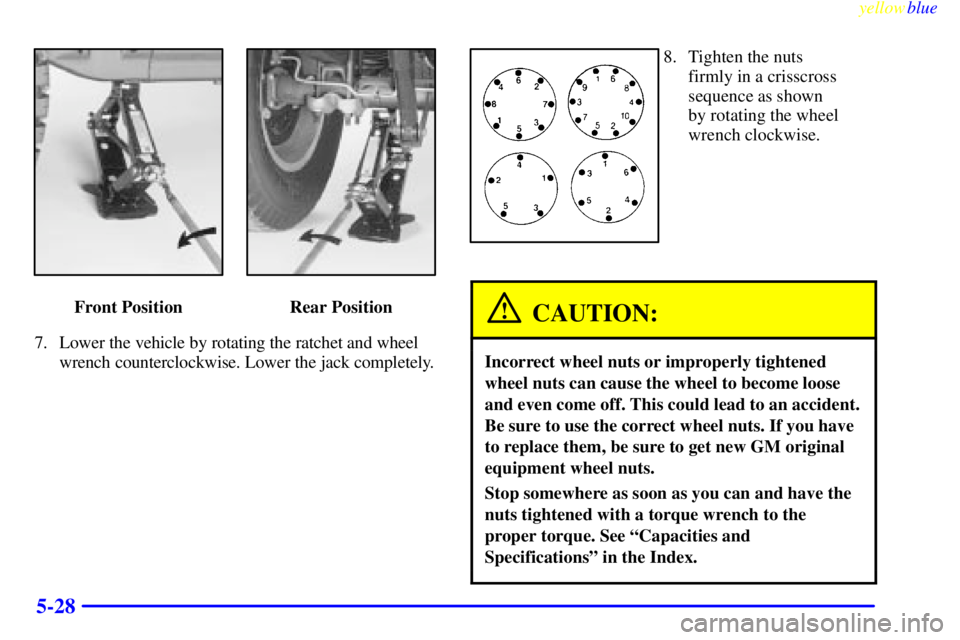
yellowblue
5-28
Front Position Rear Position
7. Lower the vehicle by rotating the ratchet and wheel
wrench counterclockwise. Lower the jack completely.
8. Tighten the nuts
firmly in a crisscross
sequence as shown
by rotating the wheel
wrench clockwise.
CAUTION:
Incorrect wheel nuts or improperly tightened
wheel nuts can cause the wheel to become loose
and even come off. This could lead to an accident.
Be sure to use the correct wheel nuts. If you have
to replace them, be sure to get new GM original
equipment wheel nuts.
Stop somewhere as soon as you can and have the
nuts tightened with a torque wrench to the
proper torque. See ªCapacities and
Specificationsº in the Index.
Page 275 of 440

yellowblue
5-29
NOTICE:
Improperly tightened wheel nuts can lead to
brake pulsation and rotor damage. To avoid
expensive brake repairs, evenly tighten the wheel
nuts in the proper sequence and to the proper
torque specification.
9. Put the wheel trim back on. For vehicles with plastic
wheel nut caps, tighten the caps until they are
finger
-tight, then tighten them an additional one-half
of a turn with the ratchet and wheel wrench.
Storing a Flat or Spare Tire and Tools
CAUTION:
Storing a jack, a tire or other equipment in the
passenger compartment of the vehicle could
cause injury. In a sudden stop or collision, loose
equipment could strike someone. Store all these
in the proper place.
Store the flat tire where the spare tire was stored.
Page 276 of 440

yellowblue
5-30
For an underbody spare tire carrier, store the tire under
the rear of the vehicle in the spare tire carrier. To store
the tire:
1. Put the tire on the ground at the rear of the vehicle
with the valve stem pointed down and to the rear.
2. Tilt the retainer downward and through the wheel
opening. Make sure that the retainer is fully seated
across the underside of the wheel.
3. Attach the ratchet, with the UP mark facing you,
near the hook at the end of the jack handle. Insert the
other end, on an angle, through the hole in the rear
bumper and into the hoist shaft.
4. Raise the tire fully against the underside of the
vehicle. Continue turning the ratchet until there are
two ªclicksº or ªratchets.º The spare tire hoist
cannot be over
-tightened.
5. Grasp and push against the tire to be sure it is stored
securely and does not move.
A. Hoist Assembly
B. Ratchet
C. Jack Handle
D. Hoist ShaftE. Valve Stem,
Pointed Down
F. Flat or Spare Tire
G. Retainer
H. Hoist Cable
Return the jack, ratchet, wheel wrench and jack
extensions to their location behind the passenger's seat.
Secure the items and replace the jack cover, if there
is one.
Page 277 of 440

yellowblue
5-31
2 and 4-Door Models
A. Nut
B. Jack
C. Jack Handle Extension
D. Wheel WrenchE. Jack and Tool
Storage Box
F. Ratchet
G. Jack Handle
H. Tool RetainerExtended Cab Models
A. Nut
B. Jack and Tool Cover
C. Jack Handle Extension
D. Tool Retainer
E. Jack and Tool
Storage BoxF. Ratchet
G. Wheel Wrench
H. Jack
I. Jack Handle
Page 278 of 440
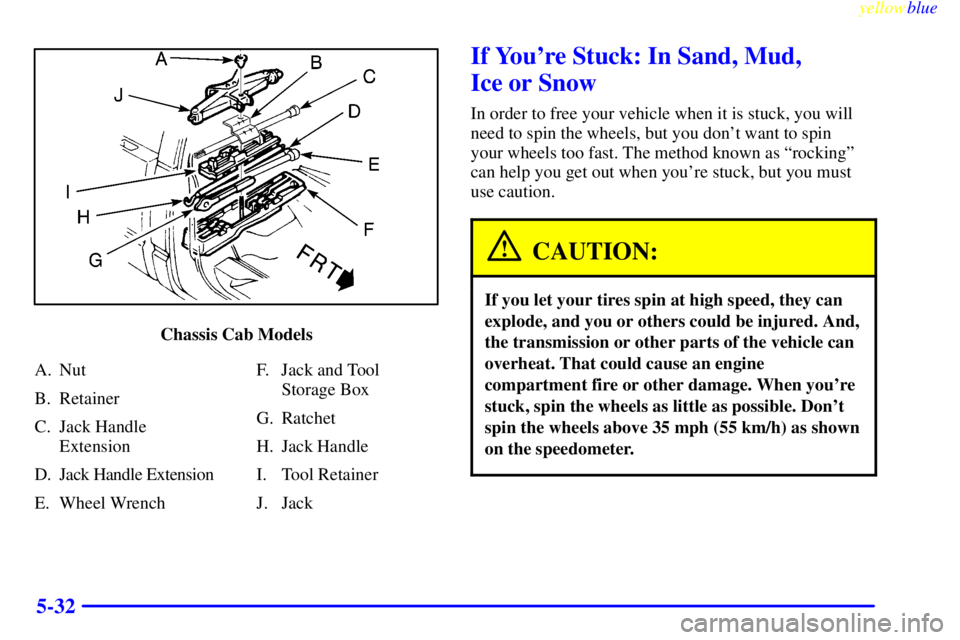
yellowblue
5-32
Chassis Cab Models
A. Nut
B. Retainer
C. Jack Handle
Extension
D. Jack Handle Extension
E. Wheel WrenchF. Jack and Tool
Storage Box
G. Ratchet
H. Jack Handle
I. Tool Retainer
J. Jack
If You're Stuck: In Sand, Mud,
Ice or Snow
In order to free your vehicle when it is stuck, you will
need to spin the wheels, but you don't want to spin
your wheels too fast. The method known as ªrockingº
can help you get out when you're stuck, but you must
use caution.
CAUTION:
If you let your tires spin at high speed, they can
explode, and you or others could be injured. And,
the transmission or other parts of the vehicle can
overheat. That could cause an engine
compartment fire or other damage. When you're
stuck, spin the wheels as little as possible. Don't
spin the wheels above 35 mph (55 km/h) as shown
on the speedometer.
Page 279 of 440
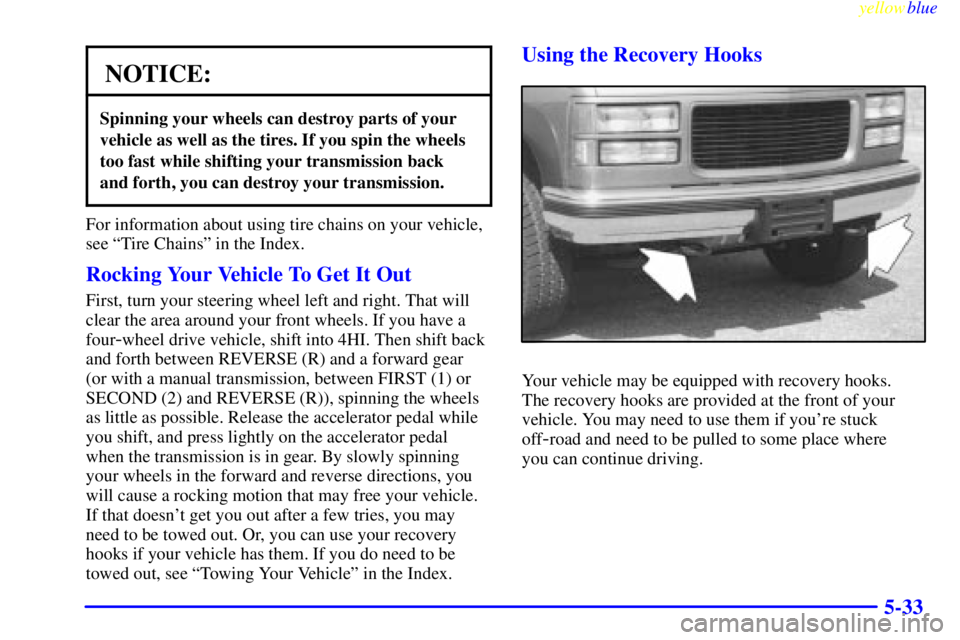
yellowblue
5-33
NOTICE:
Spinning your wheels can destroy parts of your
vehicle as well as the tires. If you spin the wheels
too fast while shifting your transmission back
and forth, you can destroy your transmission.
For information about using tire chains on your vehicle,
see ªTire Chainsº in the Index.
Rocking Your Vehicle To Get It Out
First, turn your steering wheel left and right. That will
clear the area around your front wheels. If you have a
four
-wheel drive vehicle, shift into 4HI. Then shift back
and forth between REVERSE (R) and a forward gear
(or with a manual transmission, between FIRST (1) or
SECOND (2) and REVERSE (R)), spinning the wheels
as little as possible. Release the accelerator pedal while
you shift, and press lightly on the accelerator pedal
when the transmission is in gear. By slowly spinning
your wheels in the forward and reverse directions, you
will cause a rocking motion that may free your vehicle.
If that doesn't get you out after a few tries, you may
need to be towed out. Or, you can use your recovery
hooks if your vehicle has them. If you do need to be
towed out, see ªTowing Your Vehicleº in the Index.
Using the Recovery Hooks
Your vehicle may be equipped with recovery hooks.
The recovery hooks are provided at the front of your
vehicle. You may need to use them if you're stuck
off
-road and need to be pulled to some place where
you can continue driving.
Page 280 of 440
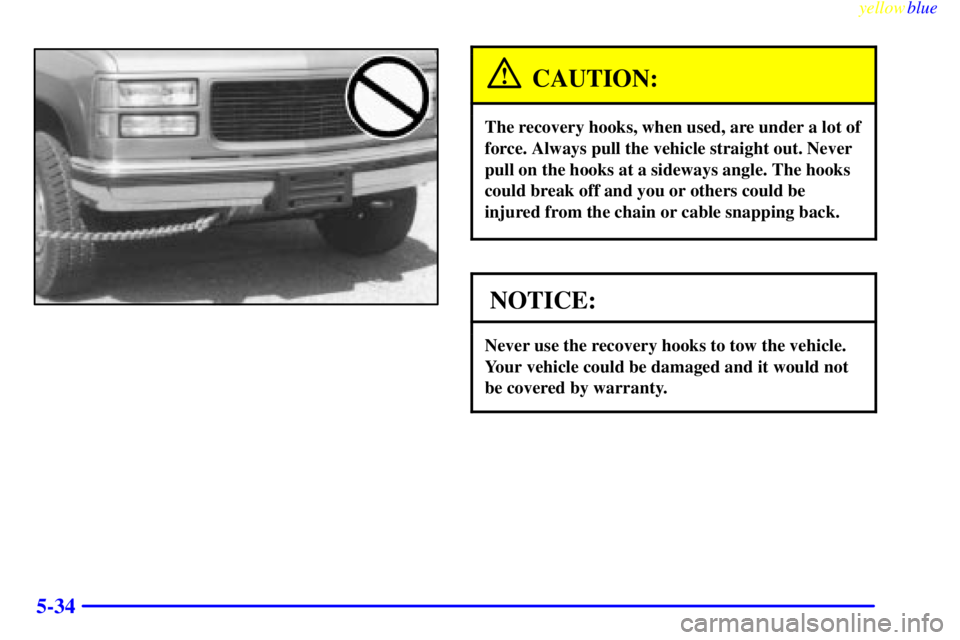
yellowblue
5-34
CAUTION:
The recovery hooks, when used, are under a lot of
force. Always pull the vehicle straight out. Never
pull on the hooks at a sideways angle. The hooks
could break off and you or others could be
injured from the chain or cable snapping back.
NOTICE:
Never use the recovery hooks to tow the vehicle.
Your vehicle could be damaged and it would not
be covered by warranty.